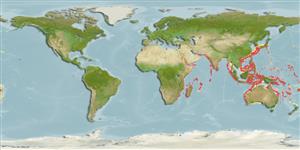Environment: milieu / climate zone / depth range / distribution range
Écologie
marin bathydémersal; profondeur 100 - 500 m (Ref. 11897). Deep-water
Indian Ocean: from the Andaman Sea and may extend nearby (i.e. India).
Taille / Poids / Âge
Maturity: Lm ? range ? - ? cm
Max length : 10.0 cm TL mâle / non sexé; (Ref. 6612)
Description synthétique
Clés d'identification | Morphologie | Morphométrie
Rayons mous dorsaux (Total) : 5; Épines anales: 0; Rayons mous anaux: 4. This species is characterized by the following: subopercular buckler dull, with many small blunt spinelets at its tip; the ventral surface is covered with small- to mid-bucklers, totally naked between these bucklers; relatively short and blunt rostrum, directed upward; principal bucklers on dorsal surface relatively small and low; dorsal surface with few brown rings (Ref. 86633).
A benthic species (Ref. 75154) found on the continental slope (Ref. 7300, 75154).
Life cycle and mating behavior
Maturité | Reproduction | Frai | Œufs | Fécondité | Larves
Paxton, J.R., D.F. Hoese, G.R. Allen and J.E. Hanley, 1989. Pisces. Petromyzontidae to Carangidae. Zoological Catalogue of Australia, Vol. 7. Australian Government Publishing Service, Canberra, 665 p. (Ref. 7300)
Statut dans la liste rouge de l'IUCN (Ref. 130435: Version 2024-2)
Menace pour l'homme
Harmless
Utilisations par l'homme
Pêcheries:
Outils
Articles particuliers
Télécharger en XML
Sources Internet
Estimates based on models
Preferred temperature (Ref.
123201): 11.8 - 22.9, mean 15.9 °C (based on 294 cells).
Phylogenetic diversity index (Ref.
82804): PD
50 = 0.5001 [Uniqueness, from 0.5 = low to 2.0 = high].
Bayesian length-weight: a=0.01479 (0.00517 - 0.04233), b=2.93 (2.68 - 3.18), in cm total length, based on LWR estimates for this (Sub)family-body shape (Ref.
93245).
Niveau trophique (Ref.
69278): 3.3 ±0.5 se; based on size and trophs of closest relatives
Résilience (Ref.
120179): Milieu, temps minimum de doublement de population : 1,4 à 4,4 années (Preliminary K or Fecundity.).
Fishing Vulnerability (Ref.
59153): Low vulnerability (10 of 100).
